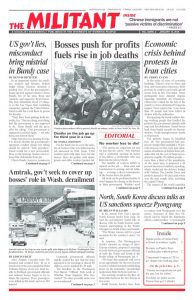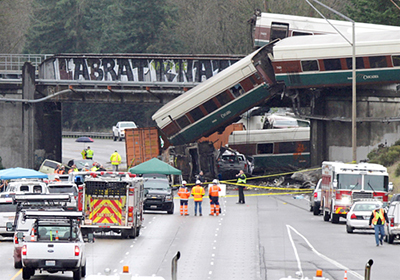After Amtrak Cascades train 501 derailed and crashed Dec. 18 as it traveled over the just completed Point Defiance Bypass on its way from Seattle to Portland, government officials and railroad bosses began to try to blame the engineer. Three passengers were killed in the crash and over 100 injured.
Unnamed government officials rapidly leaked the fact that the train appeared to be traveling at almost 80 mph in a curve marked for 30 mph.
The headline in the Washington Post blared, “Official: Feds Look at Whether Train Engineer Was Distracted.” No other possible cause was even mentioned.
But facts began coming out Dec. 23 that tell another story, a story of rushed efforts by Amtrak bosses to meet the deadline for the new service that seemed to make it impossible to be prepared.
“Anyone who points their finger at this engineer in this accident is making a very bad mistake,” John Hiatt, a former BNSF engineer and 25-year railroad investigator for the Bremseth Law firm in Minnetonka, Minnesota, told KIRO 7-TV, the CBS affiliate in Seattle. Hiatt lives in Puyallup, Washington, and had spent the last four or five days talking with Amtrak and other rail workers in the area.
The problem, he said, was that the rail bosses were in a hurry to meet a deadline and shorted the training to do so. “Deadlines can’t be the dictator of how you do things,” Hiatt said. “Safety has to be.”
“All the railroads in the country, including Amtrak, do not require training like they should,” John Risch, national legislative director of the SMART Transportation Division, which represents rail operating crew workers, told the Seattle Times.
All of the engineers who would be working the new bypass were trained at night. “All of them,” Hiatt said. “When they got off their regular run, they had to figure out a way to squeeze them some way into this training, plus be able to keep their other trains running.”
“I’ve heard six people were in the locomotive cab” at a time, Hiatt said. “They had all of them in there to qualify as a group, so they would take turns running the locomotive.”
And, he said, they did most of their training not in the front engine, but in the rear locomotive, at the back of the train.
“Riding a trailing locomotive, in the dark, what’s the benefit?” he asked. “That’s like learning to drive a car while riding in the trunk.”
Hiatt says that the fact Amtrak started the new service without having Positive Train Control operating — a system that automatically can slow or stop trains that are traveling too fast — is part of the problem. The bypass is fitted with PTC equipment, but it is not yet up and running.
Even though Congress voted in 2008 to mandate all rail bosses to put Positive Train Control on their tracks by the end of 2015, rail companies have gotten extensions, saying it’s too expensive.
Rail bosses try and isolate and fire workers who speak out about safety, Hiatt told the Militant. “What the companies do, if someone reports a safety problem,” he said, “is to get rid of them at a later date on a minor infraction, claiming there is no relationship to what the worker had reported.”
Rail bosses and their government allies go out of their way to try to pin the blame for any problem on the workers involved. That’s what Canadian rail bosses and government prosecutors are trying to do in their frame-up trial taking place now of engineer Tom Harding and traffic controller Richard Labrie in the derailment, explosion and fire that destroyed downtown Lac-Mégantic, Quebec, in 2013, killing 47 people.
John Studer contributed to this article.


